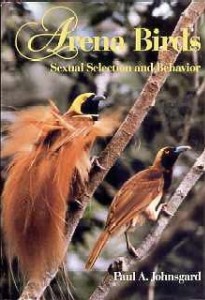Reviewed by Grant McCreary on February 18th, 2007.
Most birds pair up for breeding, with the male taking at least some part in the raising of the offspring. But in some birds a remarkable system has developed where the males will put on some kind of display to win over females. The display can be vocal, visual, or some combination of the two. Sometimes multiple males will gather together in what are known as leks. Females choose the “best” male to mate with and will then go off to raise her brood alone. Such lekking behavior is found in many different groups of birds and can take various forms. This book summarizes this interesting reproductive strategy.
The first two chapters give an introduction to the subject. The first discusses sexual selection and the second gives an overview of lekking behavior and the birds that practice it. Sexual selection is a type of natural selection where traits are evolved and passed down on the basis of reproductive success. This is a simple idea on the surface, but it has led to the extraordinary variety of behavior and physical appearances described in this book. These birds behave in odd ways (dancing, building structures, etc) and/or have some outlandish physical trait (i.e. a peacock’s tail) because that is what the females of the species look for in a mate. Apparently guys will go to great lengths to get a girl in the bird world also!
The remainder of the book details specific bird families that exhibit these traits, including ducks, grouse, bustards, shorebirds, parrots, hummingbirds, lyrebirds, cotingas, manakins, bowerbirds, birds-of-paradise, whydahs and widowbirds. Each chapter discusses the behavior of the group in general and also the displays of individual species. Black and white line drawings are used to illustrate the displays. These are helpful in visualizing what the birds do, especially where movement is involved.
This book presents an excellent overview of these birds. However, the text is very dry for such an intriguing topic. On the continuum of language from layperson to scientific it falls on the more scientific side, but is still accessible. A dry, detailed description of the behavior of species after species can get old quickly, even when the behaviors themselves are fascinating. In general I found it very hard to read for long periods of time. This will greatly depend upon the reader, however. I did not finish some chapters that I was not as interested in, but I had no such problem with others.
Sixteen pages of photographs are also included and bunched together in the middle of the book. While the line drawings do a better job of conveying the complex displays, it is very nice to have photos so that you can tell what the bird actually looks like! The birds-of-paradise, for example, need photos to show just how absolutely stunning they really are. It is a pity that more photographs couldn’t have been included.
This volume is highly recommended to anyone who has a particularly strong interest in this topic or in some of the included birds, but those who do not will probably find it difficult to get through. On the other hand, used copies can be found online very cheaply, and at these prices it is well worthwhile to anyone who may be even slightly interested.
Disclosure: I get a small commission for purchases made through links in this post.



Comment